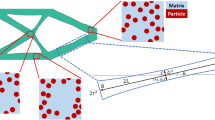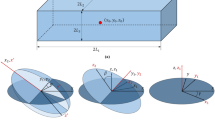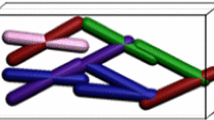Abstract
Traditional topology optimization methods often introduce weak artificial material to mimic voids to avoid the singularity of the global stiffness matrix and carry out topology optimization with a fixed finite element (FE) mesh. This treatment, however, may not only increase the computational cost for structural analysis but also lead to unfavorable numerical instabilities, especially when large deformations and dynamic/buckling behaviors are involved. In the present work, a new meshless moving morphable component-based method (ML-MMC), which structural analysis is carried out only on the solid region occupied by components, is proposed. In this approach, the coupling of discrete components is achieved through the adaptively constructed influence domain of the meshless shape function. Therefore, the singularity problem of the stiffness matrix can be naturally avoided without introducing weak artificial material. Compared with traditional methods, the number of degrees of freedoms (DOFs) can be reduced substantially under this treatment. The effectiveness of the proposed approach is also illustrated by some representative examples.

摘要
传统拓扑优化方法往往需引入人工弱材料来模拟孔洞, 以避免整体刚度矩阵的奇异性, 并使用固定的有限元网格进行分析和优化. 然而, 这种处理方法不仅会增加结构分析的计算成本, 还会导致不利的数值不稳定性, 尤其是当涉及大变形和动力/屈曲行为时. 本文提出了一种新的基于无网格的移动可变形组件拓扑优化方法(ML-MMC), 该方法只对组件占据的实体区域进行结构分析, 并通过自适应构造无网格形函数的影响域来实现离散组件的耦合, 可以在不引入人工弱材料的情况下自然地避免拓扑优化过程中刚度矩阵的奇异性问题. 与传统拓扑优化方法相比, 这种处理方法可以大大减少优化过程中结构分析的自由度(DOFs)数量. 一些典型的二维和三维算例说明了该方法的有效性和高效性.
Similar content being viewed by others
References
M. P. Bendsøe, and N. Kikuchi, Generating optimal topologies in structural design using a homogenization method, Comput. Methods Appl. Mech. Eng. 71, 197 (1988).
M. P. Bendsøe, and O. Sigmund, Material interpolation schemes in topology optimization, Arch. Appl. Mech. 69, 635 (1999).
Y. M. Xie, and G. P. Steven, A simple evolutionary procedure for structural optimization, Comput. Struct. 49, 885 (1993).
J. A. Sethian, and A. Wiegmann, Structural boundary design via level set and immersed interface methods, J. Comput. Phys. 163, 489 (2000).
M. Y. Wang, X. Wang, and D. Guo, A level set method for structural topology optimization, Comput. Methods Appl. Mech. Eng. 192, 227 (2003).
G. Allaire, F. Jouve, and A. M. Toader, Structural optimization using sensitivity analysis and a level-set method, J. Comput. Phys. 194, 363 (2004).
X. Guo, W. Zhang, and W. Zhong, Doing topology optimization explicitly and geometrically—A new moving morphable components based framework, J. Appl. Mech. 81, 081009 (2014).
W. Zhang, D. Li, J. Zhou, Z. Du, B. Li, and X. Guo, A Moving Morphable Void (MMV)-based explicit approach for topology optimization considering stress constraints, Comput. Methods Appl. Mech. Eng. 334, 381 (2018).
J. A. Norato, B. K. Bell, and D. A. Tortorelli, A geometry projection method for continuum-based topology optimization with discrete elements, Comput. Methods Appl. Mech. Eng. 293, 306 (2015).
J. Norato, R. Haber, D. Tortorelli, and M. P. Bendsøe, A geometry projection method for shape optimization, Int. J. Numer. Meth. Engng. 60, 2289 (2004).
X. Guo, and G. D. Cheng, Recent development in structural design and optimization, Acta Mech. Sin. 26, 807 (2010).
P. Fernandes, J. M. Guedes, and H. Rodrigues, Topology optimization of three-dimensional linear elastic structures with a constraint on “perimeter”, Comput. Struct. 73, 583 (1999).
W. Zhang, W. Yang, J. Zhou, D. Li, and X. Guo, Structural topology optimization through explicit boundary evolution, J. Appl. Mech. 84, 011011 (2017).
Z. Wu, S. Wang, R. Xiao, and L. Yu, A local solution approach for level-set based structural topology optimization in isogeometric analysis, J. Comput. Des. Eng. 7, 514 (2020).
N. L. Pedersen, Maximization of eigenvalues using topology optimization, Struct Multidisc Optim 20, 2 (2000).
S. H. Ha, and S. Cho, Level set based topological shape optimization of geometrically nonlinear structures using unstructured mesh, Comput. Struct. 86, 1447 (2008).
T. E. Bruns, and D. A. Tortorelli, An element removal and reintroduction strategy for the topology optimization of structures and compliant mechanisms, Int. J. Numer. Meth. Engng. 57, 1413 (2003).
T. E. Bruns, Zero density lower bounds in topology optimization, Comput. Methods Appl. Mech. Eng. 196, 566 (2006).
Q. K. Nguyen, S. Serra-Capizzano, and E. Wadbro, On using a zero lower bound on the physical density in material distribution topology optimization, Comput. Methods Appl. Mech. Eng. 359, 112669 (2020).
E. Shakour, and O. Amir, Topology optimization with precise evolving boundaries based on IGA and untrimming techniques, Comput. Methods Appl. Mech. Eng. 374, 113564 (2021).
G. Allaire, C. Dapogny, and P. Frey, A mesh evolution algorithm based on the level set method for geometry and topology optimization, Struct. Multidisc. Optim. 48, 711 (2013).
G. Allaire, C. Dapogny, and P. Frey, Shape optimization with a level set based mesh evolution method, Comput. Methods Appl. Mech. Eng. 282, 22 (2014).
F. Feppon, G. Allaire, C. Dapogny, and P. Jolivet, Topology optimization of thermal fluid-structure systems using body-fitted meshes and parallel computing, J. Comput. Phys. 417, 109574 (2020).
F. Feppon, G. Allaire, C. Dapogny, and P. Jolivet, Body-fitted topology optimization of 2D and 3D fluid-to-fluid heat exchangers, Comput. Methods Appl. Mech. Eng. 376, 113638 (2021).
S. Yamasaki, A. Kawamoto, T. Nomura, and K. Fujita, A consistent grayscale-free topology optimization method using the level-set method and zero-level boundary tracking mesh, Int. J. Numer. Meth. Engng. 101, 744 (2015).
S. Yamasaki, S. Yamanaka, and K. Fujita, Three-dimensional grayscale-free topology optimization using a level-set based r-refinement method, Int. J. Numer. Meth. Engng. 112, 1402 (2017).
K. Nomura, S. Yamasaki, K. Yaji, H. Bo, A. Takahashi, T. Kojima, and K. Fujita, Topology optimization of conductors in electrical circuit, Struct. Multidisc. Optim. 59, 2205 (2019).
Q. Xia, T. Shi, S. Liu, and M. Y. Wang, A level set solution to the stress-based structural shape and topology optimization, Comput. Struct. 90–91, 55 (2012).
Q. Xia, and T. Shi, Optimization of structures with thin-layer functional device on its surface through a level set based multiple-type boundary method, Comput. Methods Appl. Mech. Eng. 311, 56 (2016).
Z. Li, T. Shi, and Q. Xia, Eliminate localized eigenmodes in level set based topology optimization for the maximization of the first eigen-frequency of vibration, Adv. Eng. Software 107, 59 (2017).
W. Zhang, J. Chen, X. Zhu, J. Zhou, D. Xue, X. Lei, and X. Guo, Explicit three dimensional topology optimization via Moving Morphable Void (MMV) approach, Comput. Methods Appl. Mech. Eng. 322, 590 (2017).
W. Zhang, Z. Xiao, C. Liu, Y. Mei, S. Youn, and X. Guo, A scaled boundary finite element based explicit topology optimization approach for three-dimensional structures, Int. J. Numer. Methods Eng. 121, 4878 (2020).
W. Khan, W. Siraj-ul-Islam, and B. Ullah, Structural optimization based on meshless element free Galerkin and level set methods, Comput. Methods Appl. Mech. Eng. 344, 144 (2019).
Z. Luo, N. Zhang, W. Gao, and H. Ma, Structural shape and topology optimization using a meshless Galerkin level set method, Int. J. Numer. Meth. Engng. 90, 369 (2012).
T. Belytschko, Y. Y. Lu, and L. Gu, Element-free Galerkin methods, Int. J. Numer. Meth. Engng. 37, 229 (1994).
X. Zhang, X. Liu, M. W. Lu, and Y. Chen, Imposition of essential boundary conditions by displacement constraint equations in meshless methods, Commun. Numer. Meth. Engng. 17, 165 (2001).
M. P. Bendsoe, and O. Sigmund, Topology Optimization: Theory, Methods and Applications. (Springer, Berlin, 2004).
C. Liu, Y. Zhu, Z. Sun, D. Li, Z. Du, W. Zhang, and X. Guo, An efficient moving morphable component (MMC)-based approach for multi-resolution topology optimization, Struct. Multidisc. Optim. 58, 2455 (2018).
K. Svanberg, The method of moving asymptotes—A new method for structural optimization, Int. J. Numer. Meth. Engng. 24, 359 (1987).
Author information
Authors and Affiliations
Corresponding authors
Additional information
This work was supported by the National Natural Science Foundation (Grant Nos. 11821202, 11732004, 12002077 and 12002073), the National Key Research and Development Plan (Grant No. 2020YFB1709401), the Fundamental Research Funds for the Central Universities (Grant Nos. DUT21-RC(3)076 and DUT20RC(3)020), the Doctoral Scientific Research Foundation of Liaoning Province (Grant No. 2021-BS-063), and 111 Project (Grant No. B14013).
Rights and permissions
About this article
Cite this article
Li, L., Liu, C., Du, Z. et al. A meshless moving morphable component-based method for structural topology optimization without weak material. Acta Mech. Sin. 38, 421445 (2022). https://doi.org/10.1007/s10409-022-09021-8
Received:
Accepted:
Published:
DOI: https://doi.org/10.1007/s10409-022-09021-8




